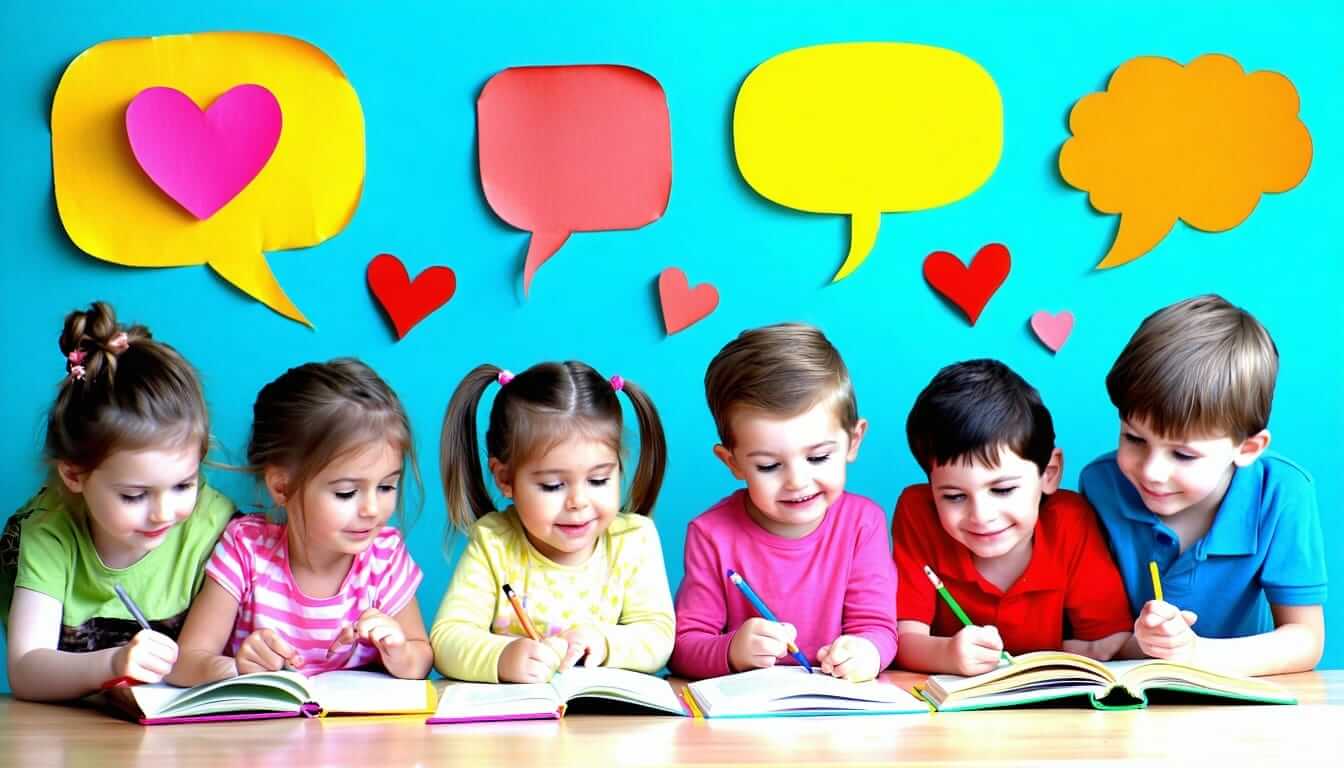Teaching Respect Through Everyday Interactions
Helping kids learn respect starts with the little, everyday moments. These are prime opportunities to teach and shape them into kind, aware folks who know how to show respect.
Understanding the Value of Respect
Respect—it’s that magic ingredient you notice when it’s there and miss when it’s gone. Kids grasping its value is key for making strong friendships and a happy space. Get your kid thinking about what respect means to them. Chat about who they think deserves it and how you earn it. These talks can build a solid habit of respectful behavior.
Before you do any teaching, agree on what respect means in your family, then dig into what respectful actions look like. Here’s what to chat about:
| What to Talk About | Why It’s Important |
|---|---|
| What Respect Is | Define it clearly for your family. |
| Who Should Get Respect | Discuss all types, from pals to parents and teachers. |
| How Respect Looks in Real Life | Use real, everyday examples. |
Need more options? Look at our respect activities for kids.
Importance of Time and Consistency
Giving kids a sense of respect isn’t a one-and-done deal—it takes time and sticking with it. Kids get it best when they see and do it often. Make learning about respect a team effort and show respect yourself as a model.
Creating habits and giving dates to respectful moments makes it sink in. Consistently using polite speech, paying attention, and acting with care around others sets a prime example for them over time. Get in on extra fun with character building activities to help this stick.
Building respect in kids means seeing things their way and guiding them when social tangles pop up. Talk about who deserves their respect and have chats they can handle to sidestep confusion or upset.
Looking for more tips on teaching respect? Our write-ups on teaching respect to children and instilling respect in kids are full of aces. Chatting with your kid about respect sets them up for life with this top-tier trait.
Modeling Respectful Behavior
Teaching kids about respect isn’t just about words; it’s about action. Kids pick up cues from the grown-ups around them, so living respect is the best ticket for helping them learn what it means.
Showing Respect in Action
Respect starts with the everyday stuff. Little things count—like really tuning in when your child’s talking, asking for their two cents, and making sure you see their side of things. Here’s how it breaks down:
| Action | Description |
|---|---|
| Active Listening | Look them in the eye, nod along, and have real conversations about what they’re saying. |
| Acknowledging Feelings | Let them know their feelings are heard and valid–show them you get it. |
| Using Polite Language | Words like “please,” “thank you,” and “excuse me” aren’t just for special occasions. They show respect in action every day. |
When you do these things, you’re not just talking respect; you’re living it right in front of them. Brightwheel says it’s all about showing kids what it’s like to be heard and valued. You might want to check out some respect activities for kids for more ways to put it into practice.
Encouraging Empathy and Acceptance
Building empathy is the real heart of teaching respect. Get your child to step into others’ shoes by chatting about different situations, like things that happen at school. It helps them see the world through different lenses.
| Empathy Activity | Description |
|---|---|
| Role-Playing | Swap roles for fun games that let your child see through someone else’s eyes. |
| Story Sharing | Dive into books that show off themes of acceptance and diversity, chatting about the characters’ feelings. |
| Group Activities | Jump into community projects or teamwork exercises that promote working together and understanding differences. |
Boosting your child’s empathy not only strengthens their respect for others but also fits right in with diversity, equity, and inclusion (Brightwheel). Dive into some character building activities for kids for more ways to nurture these qualities.
By weaving these habits into your daily routine, you’re setting the stage for a space where respect and empathy grow naturally, helping your kids to build their social and emotional skills. For more ideas on this journey, think about checking out tips for teaching respect through empathy.
Building Respect Through Cultural Diversity
Teaching kids to be respectful is more than just words; it’s about opening their eyes to the rich variety of the world they live in. By introducing them to different cultures early on, you plant seeds of respect and acceptance that grow as they do.
Cultivating Inclusion and Appreciating Differences
If you want kids to embrace cultural diversity, create a space that doesn’t just tolerate differences but celebrates them. When kids are exposed to varied backgrounds, it isn’t just about ticking a box. It’s about widening their minds and teaching them empathy and respect. Kids who see the world from different angles tend to be more accepting and better citizens of the earth (you know, like peace ambassadors in their own little way) CCEI Online.
When kids dive into books, tunes, and art from different cultures, they come to appreciate the world’s colorful tapestry. Engaging with diverse cultures not only gives a boost to their social skills but helps them become more rounded individuals. Here’s what a dose of diversity can brew up:
| Benefit | What’s it About |
|---|---|
| More Acceptance | Kids learn the beauty of being different yet the same. |
| Smarter Social Skills | Mixing with kids from varied backgrounds sharpens their communication. |
| Empathy Booster | Meeting new cultures gear up their hearts and minds for compassion. |
| Academic Edge | Diversity in thought often translates into better school performance. |
| Creative Brainstorming | Different ways of seeing spark brilliant new ideas. |
Cultural Awareness Activities
Getting kids involved in activities that focus on diverse cultures can be a real game-changer. These activities aren’t just educational but also loads of fun, introducing them to the traditions that make each culture unique. Here’s a quick list of simple yet awesome activities you might want to try:
- Storytime Around the World: Grab some books from different cultures and dive into discussions about their stories and lessons.
- Cultural Festivities: Host events where families can share food, music, and clothes from their own cultures – kind of like a global potluck!
- Artistic Adventures: Encourage kids to create pieces inspired by art styles from around the world. Unique materials and methods are a bonus.
- Tune Travels: Spin music from different parts of the globe, letting kids groove to the world’s beat.
- Taste-Test Tours: Try out simple recipes from various spots on the map, making lessons yummy and hands-on.
Looking for ways to keep the respect lessons rolling? Check out our respect activities for kids. By intertwining cultural learning with day-to-day activities, you’re building a solid base for kindness and understanding that’ll stick with them for life. If you’re keen on exploring more, head over to our guides on teaching respect to children and instilling respect in kids.
Teaching Respect towards Authority
Demonstrating Humility and Accountability
Here’s the deal: you play a huge part in teaching your kids about respecting folks in charge—teachers, parents, and those community peeps. It’s all about showing them the ropes when it comes to humility, owning up to mistakes, and being responsible. These traits help them handle interactions with the big shots more smoothly. At the same time, it’s super smart to let them ask questions about the world around them, but with a good sprinkle of respect. This way, they learn to build confidence while understanding the value of listening to authority figures. According to the The Children’s Trust, that’s a win-win.
Want to teach humility and accountability? Start by showing you’re human too—no one’s perfect! Admitting your mistakes openly can encourage your kiddo to own up to theirs. It’s like a domino effect of responsibility.
Setting Expectations and Consequences
Expectations for behavior don’t need to be rocket science, but they do need to be clear. Lay out what you mean by “respect” when it comes to dealing with authority. Cover the basics and explain why they matter.
| Respectful Behavior | Explanation |
|---|---|
| Listening attentively | Shows you’re tuned in and value what others say |
| Asking questions politely | Stirs curiosity without stepping on toes |
| Following rules | Helps keep the social gears running smoothly |
And don’t forget the flip side: what happens when respect goes out the window. Being consistent here is your secret weapon. If they know there’s a cost to stepping out of line, they’re way more likely to keep it in check. Spend some time laying it all out, so they know what’s up. Pop in often to reinforce these ground rules and set them up for success. Need more guidance? Check out our guides on teaching respect to kids and lessons about respect to give your young ones an extra boost.
Building accountability and solid boundaries helps your child balance respecting authority with fueling their endless curiosity. It’s all about giving them the tools to respect others while staying true to their own inquisitive selves.
Engaging Children in Respectful Discussions
Getting kids to chat about respect sounds like a big deal, but it’s basically setting them up to deal with the world a bit more gracefully. Here’s a no-nonsense way to think about it: dig into their thoughts and cheer them on when they get it right.
Reflecting on Personal Beliefs
Kicking things off, have the kiddos mull over their ideas about respect. You know, leaping into their minds a bit. Try out questions like:
- Who do you think should get respect?
- How do you stay cool and kind even when you don’t agree with someone?
- Can you recall a moment recently when you saw someone being really respectful?
Encourage them to ponder and chat back. To make things a bit easier, use sentence starters like these:
| Starter | Example |
|---|---|
| “Respect means…” | “Respect means giving others a chance to speak.” |
| “I feel respected when…” | “I feel respected when people don’t interrupt me.” |
| “I can show respect by…” | “I can show respect by saying ‘thank you’ and ‘please’.” |
This thinking stuff is the base for getting genuine respect down pat. Want more? Check out our deeper dive into teaching respect to children.
Identifying and Rewarding Respectful Behavior
Spotting and clapping for respectful acts cements everything learned in. Ever tried “Kudos Cards”? It’s like a mini shout-out for good behavior during group stuff (The Responsive Counselor).
Consider a rewards game at home too. Look at this for a kick-off:
| Action | Prize |
|---|---|
| Being generous with toys | Sticker for the chart |
| Speaking kindly | Earn a couple more minutes of fun time |
| Lending a helping hand | Sweet treat post-dinner |
These setups let kids see respect in action and how to up their game. Toss in some hands-on fun like respect-themed puzzles to keep the learning lively. Dive into more cool ideas at respect activities for kids.
Help your kiddos reflect and ‘wow’ the respect meters as they grow. You’re crafting mini adults ready to take on their social worlds with grace and kindness.
Impact of Parental Attitudes on Respect
The way you handle parenting can significantly shape how your kids learn to respect others. It’s not just about teaching respect, it’s about showing it through your actions and creating a safe place where they feel it every day.
Influence of Warmth and Control
How you mix kindness with rules can really affect your child’s respect levels. Being warm shows love and support. Having rules means setting limits and standards. Kids do better when they feel loved but also know what’s expected of them.
Here’s a breakdown of how your parenting style might play into this:
| Parenting Style | What It Looks Like | Impact on Respect |
|---|---|---|
| Authoritative | Lots of love, clear rules | Kids learn to respect authority and peers |
| Authoritarian | Less love, more strict rules | Might make them scared instead of respecting |
| Permissive | Lots of love, few rules | Could cause trouble with authority and boundaries |
| Neglectful | Low love, few rules | Often leads to a lack of respect and self-esteem |
Showing respect in your dealings with your children sets a benchmark for them in their relationships. For more on showing respect effectively, check out our teaching respect to children resources.
Empowering Children through Participation
Letting your kids have a say in things affecting their lives can boost their confidence. It teaches them not just respect, but also how to stand on their own two feet. Empowering them involves listening to their opinions and including them in decisions.
Critical ways to empower your child include:
- Information – Make sure they’re informed so they can make smart choices.
- Autonomy – Support their freedom to express opinions and make decisions.
- Recognition – Listen to them and show their thoughts matter.
- Alliance – Collaborate with them to build a mutual respect-based relationship.
These steps can help your child handle relationships better and instill self-respect as well. Studies highlight how letting kids in on decision-making can grow respect in the family setting (NCBI).
Start by getting your kids involved in daily choices, like picking out weekend activities or taking part in family talks. For more fun ways to teach respect, visit our respect activities for kids page.
By creating a warm environment and getting your kids involved, you’re not just helping them understand respect; you’re equipping them with a lifelong value they’ll carry forward.




